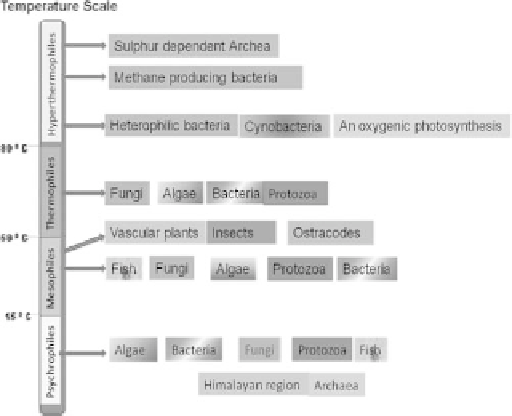Environmental Engineering Reference
In-Depth Information
Fig. 1
Classification of microorganism based on the sustainable temperature [61]
The hyper-thermophilic microorganisms belonging to archaeabacteria include
Pyrolobus fumarii
(Crenarchaeota), a nitrate-reducing chemolithoautotrophic bac-
terium, grow at 113
◦
C [15]. The enzymes derived from hyper-thermophilic bacteria
have shown maximum catalytic activity at higher temperature such as the maximum
amylopullulanase activity was reported at 142
◦
C [83]. There are distinguished ther-
mophiles among the phototrophic bacteria (cyanobacteria, purple and green bacte-
ria), eubacteria (
Bacillus
,
Clostridium
,
Thiobacillus
,
Desulfotomaculum
,
Thermus
,
lactic acid bacteria, Actinomycetes, Spirochetes etc.) and the archaea (
Pyrococcus
,
Thermococcus
,
Thermoplasma
,
Sulfolobus
and Methanogens). Invariably, the upper
limit of temperature to sustained in an environment for eukaryotes including proto-
zoa, algae and fungi is reported ~60
◦
C. It is known that various microbes and animal
cell lines are being preserved at -196
◦
C (liquid nitrogen), whereas, lowest recorded
temperature for an active microbial growth is -118
◦
C. At low temperatures water
freezes and ice crystal formed inside the cells. Ice crystals can rip cell membranes,
and solution chemistry stops in the absence of liquid water. Freezing of intracellular
water can be lethal to the living entities. The only exception to this rule reported so
far, was a nematode
Panagrolaimus davidi.
This nematode was able to survive even
after freezing of all body water [92].
2.1.2 Radiation
Radiation is energy in the form of either particles (i.e. neutrons, electrons, protons,
alpha and beta particles or heavy ions) or electromagnetic waves (i.e. gamma rays,
X-rays, ultraviolet (UV) radiation, visible light, infrared, microwaves or radio waves
etc). Radiation background levels beyond the accepted limit are sufficient to qualify

Search WWH ::

Custom Search